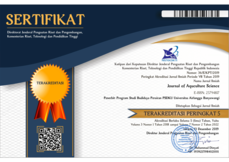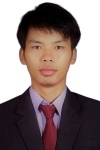Environmental Rehabilitation Through Community-Based Mangrove Replanting Action As A Sustainable Fisheries Campaign: A Case Study At Binanga Sangkara, Maros, South Sulawesi
Downloads
Mangrove, a unique ecosystem commonly situated on the coast, has a very vital role for the living creatures both inhabiting in and around the ecosystem. As the biggest mangrove forest holder in the world, Indonesia owns its great potential for both sustainable fisheries and community welfare. In order to preserve the mangrove ecosystem for sustainable fisheries, environmental improvement through mangrove rehabilitation program is important. WWF Indonesia collaborated with PT. Bogatama Marinusa (PT. Bomar) implement a mangrove rehabilitation program to support ASC (Aquaculture Stewardship Council) shrimp certification. The activity was implemented on 2019 at Binangasangka, Maros, South Sulawesi. The program was implemented in several steps namely planning, consolidation to communities, socialization and local support, seed preparation, planting, and monitoring and evaluation. The whole program has engaged multiple local environment-concern communities, especially youth community, and have collaborated significant local stakeholders namely the Institute of Brackish Aquaculture Research of Maros and the Technology University of Sulawesi, as well embraced local society. In the end, about 24 thousand mangrove seeds have been planted and covering up to 1 hectare. From the mentioned number, the successfully survived seeds have reached 74 % and hopefully well-settled in future. The overall activities were expected to contribute not only expanding mangrove coverage in coastal area, but also being the educational tools about environmental awareness to young generation.
Keywords: mangrove, rehabilitation, community, Maros.
Anggraeni, M., Rustiadi, E., dan Yulianto, G. (2020). Peranan Sektor Perikanan Terhadap Perekonomian Kabupaten Natuna. Jurnal Kebijakan Sosial Ekonomi Kelautan dan Perikanan, 10(1): 11-23.
Arifin, M. Z., Mulalinda, P., Kalesaran, J., Tauladani, S., dan Asia, A. (2019). Studi Tingkat Keberhasilan Penanaman Mangrove di Pesisir Desa Dagho, Kabupaten Kepulauan Sangihe, Desa Matahit Kabupaten Kepulauan Talaud dan Kelurahan Pasirpanjang, Kecamatan Lembeh Selatan, Kota Bitung. Frontiers: Jurnal Sains Dan Teknologi, 2(1).
Asiati, D., dan Nawawi, N. F. N. (2017). Kemitraan Di Sektor Perikanan Tangkap: Strategi untuk Kelangsungan Usaha dan Pekerjaan. Jurnal Kependudukan Indonesia, 11(2): 103-118.
Badan Pusat Statistik Provinsi Sulawesi Selatan (2019). Statistik Provinsi Sulawesi Selatan Dalam Angka. BPS Sulsel.
Nugroho, A. (2017). Geliat Organisasi Pemuda Lingkungan (Opl) Dalam Ranah Gerakan Lingkungan Di Yogyakarta. Jurnal Sosiologi Agama, 9(1): 190-148.
Bappenas (2014). Kajian Strategi Pengelolaan Perikanan Berkelanjutan. Jakarta (ID): Bappenas.
Biswas, S. R., Mallik, A. U., Choudhury, J. K., dan Nishat, A. (2009). A unified framework for the restoration of Southeast Asian mangroves”bridging ecology, society and economics. Wetlands Ecology and Management, 17(4): 365-383.
Buckley, S. (2012). Higher Education and Knowledge Sharing: From Ivory Tower to Twenty-first Century. Innovations in Education and Teaching international, Vol. 49(3): 333-344.
Suharko, Alam, M., Madya, S.H., Prastowo, F.R., dan Nugroho, A. (2014). Organisasi Pemuda Lingkungan di Indonesia Pasca-Orde Baru, Gadjah Mada University Press, Yogyakarta.
FAO (1982). Management and Utilization of Mangrove in Asia and the Pacific. Rome: FAO Environment Paper 3.
Fitri, R.Y. dan Anwar, K. (2014). Kebijakan Pemerintah terhadap Pelestarian Hutan Mangrove di Kecamatan Tebing Tinggi Kabupaten Bengkalis. Jom FISIP 1(2):1-15.
Giesen, W., Wulffraat, S., Zieren, M., Scholten, L. (2007). Mangrove guidebook for Southeast Asia. FAO Regional Office for Asia and the Pacific, Bangkok.
Hafni, R. (2016). Analisis Dampak Rehabilitasi Hutan Mangrove terhadap Pendapatan Masyarakat Desa Lubuk Kertang Kabupaten Langkat. Jurnal Ekonomikawan, 16(2): 78262.
Makaruku, A., dan Aliman, R. (2019). Analisis Tingkat Keberhasilan Rehabilitasi Mangrove Di Desa Piru Kecamatan Seram Barat Kabupaten Seram Bagian Barat. Jurnal Rekayasa Lingkungan, 19(2).
Manassrisuksi, K., M. Weir, and Y.A. Hussin (2001). Assesment of mangrove rehabilitation programme using remote sensing and GIS: a case study of Amphur Khlung, Chantaburi Province, Eastern Thailand. 22nd Asian Conference on Remote Sensisng, Singapore 5-9 November 2001
Ong, J.E (2002). The hidden costs of mangrove services: use of mangroves for shrimp aquaculture. International Science Round Table for the Media, Bali Indonesia, 4 June 2002. Joint event of ICSU, IGBP, IHDP, WCRP, DIVERSITAS and START.
Parker, W.C. dan Hess, D. (2000). Teaching with and for Discussion. Teaching and Teacher Education, 17: 273-289
Rizki, R., dan Novi, N. (2017). Respon pertumbuhan bibit mangrove Rhizophora apiculata B1 pada media tanah top soil. Jurnal Bioconcetta, 3(2), 41-54.
Setiawan, H. (2015). Studi pengelolaan hutan mangrove sebagai bahan baku industri arang di Pulau Tanakeke Kabupaten Takalar Sulawesi Selatan. In Seminar Nasional Sewindu BPTHHBK Mataram: Pengarusutamaan Hasil Litbang Lingkungan Hidup dan Kehutanan sebagai Lokomotif Pembangunan Berkelanjutan (pp. 597-605).
Setyawan, A.D., Winarno, K., dan Purnama, P.C. (2003). Ekosistem Mangrove di Jawa: 1. Kondisi Terkini. Biodiversitas,4,(2): 130-142
Sohail, M.S. dan Daud, S. (2009). Knowledge Sharing in Higher Education Institutions: Perspectives from Malaysia. The Journal of Information and Knowledge Management Systems, 39(2): 125-142
Spalding, M., Blasco, F., dan Field, C. (1997). World Mangrove Atlas. Okinawa: International Society for Mangrove Ecosystems.
Spaninks, F. and P. van Beukering (1997). Economic Valuation of Mangrove Ecosystems: Potential and Limitations. CREED Working Paper No 14, July 1997. London and Amsterdam: International Institute for Environment and Development, and Institute for Environmental Studies
Sugiarto dan Ekariyo, W. (1996). Penghijauan pantai. PT. Penebar Swadaya, Jakarta.
Supriharyono (2007). Konservasi Ekosistem Sumberdaya Hayati Di Wilayah Pesisir dan Laut Tropis, Pustaka Pelajar, Yogyakarta.
Syamsu, I. F., nugraha, A. Z., nugraheni, C. T., dan Wahwakhi, S. (2018). Kajian perubahan tutupan lahan di ekosistem mangrove Pantai Timur Surabaya. Media Konservasi, 23(2): 122-131.
Wibisono, I.T.C., Priyanto, E.B., Suryadiputra, I.N.N. (2006). Panduan Praktis Rehabilitasi Pantai. Wetlands International Indonesia Programme, Bogor, Indonesia.
Winata, A., dan Yuliana, E. (2016). Tingkat keberhasilan penanaman pohon mangrove (kasus: pesisir Pulau Untung Jawa Kepulauan Seribu). Jurnal Matematika Sains dan Teknologi, 17(1): 29-39.



















